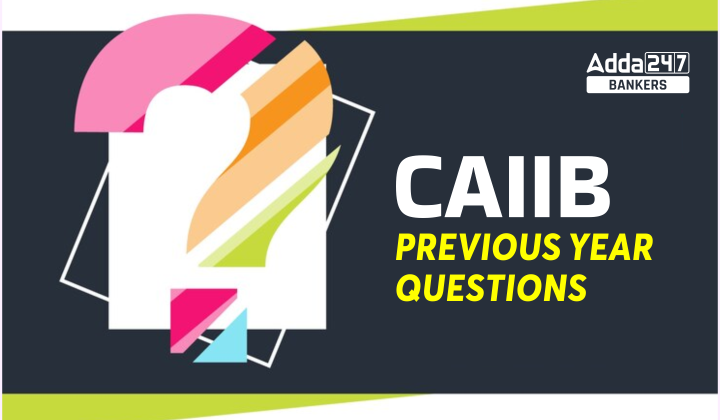Table of Contents
The CAIIB Previous Year Question Papers are essential study materials for candidates preparing for the June 2025 session. As the Certified Associate of the Indian Institute of Bankers (CAIIB) exam helps banking professionals advance their careers, practicing past papers enhances preparation. These papers provide insights into the exam pattern, difficulty level, and frequently asked topics. With registration open for the June 2025 session, now is the right time to strengthen your preparation. Download the free PDF of previous year question papers to boost your chances of success.
CAIIB Previous Year Question Papers
A cohort of first-time CAIIB Exam candidates would benefit from solving previous year question papers to excel in the examination on their first attempt. By practicing with these papers, candidates can grasp the marking scheme and gain insights into various aspects of the CAIIB Exam 2025. The provided Free PDF includes previous year papers for both compulsory and elective subjects of the CAIIB Exam.
To aid candidates in their preparation journey, Adda247 has curated a meticulously compiled PDF containing the CAIIB previous year’s question papers. This invaluable compilation offers aspirants an in-depth understanding of the examination pattern, question types, and the level of complexity they can expect to encounter.
Also Read, CAIIB Exam Date 2025
CAIIB Previous Year Questions, Download PDF
CAIIB Previous Year Questions have been provided for the four compulsory papers: Advanced Bank Management(ABM), Bank Financial Management(BFM), Advanced Business and Financial Management (ABFM), Banking Regulations and Business Laws (BRBL) and one elective paper(Rural Banking, Human Resources Management, Risk Management, Central Banking, and Information Technology & Digital Banking). Aspirants can download the CAIIB Previous Year Questions PDF from the below-provided link.
| CAIIB Previous Year Questions | |
| Section | PDF Link |
| CAIIB Previous Year Questions | Download PDF |
CAIIB Previous Year Questions: Benefits
There are various benefits of solving CAIIB Previous Year Question Papers, some of which have been listed down below.
- Exam Pattern Familiarity: Solving CAIIB Previous Year Questions helps aspirants grasp the exam structure, question types, and mark distribution across various topics.
- Understanding Key Topics: CAIIB Previous Year Paper helps in identifying frequently tested topics and concepts, enabling banking and financial sector employees to prioritize their study focus.
- Practice and Time Management: Regular practice enhances speed, accuracy, and time management skills, crucial for performing well in the CAIIB exam.
- Weak Area Identification: Analyzing performance in CAIIB’s previous year’s question papers helps candidates pinpoint weak areas allowing for targeted improvement strategies.
- Confidence Boost: Increasing familiarity with CAIIB questions boosts confidence, vital for success on exam day.
- Concept Revision: Solving CAIIB Previous Year Paper serves as a revision tool reinforcing understanding and retention of important concepts.
- Predicting Question Trends: Familiarity with asked questions helps in predicting potential question trends ultimately leading in better preparation.
- Simulating Exam Conditions: Practicing under timed conditions replicates the exam environment, reducing anxiety and increasing comfort during the actual CAIIB exam.
Also Read, CAIIB Registration 2025
Which type of Questions are asked in CAIIB Exam?
The CAIIB exam features a variety of question types, primarily focusing on multiple-choice questions (MCQs) that test the candidate’s knowledge and understanding of banking and financial concepts. The questions typically cover topics such as risk management, financial management, banking regulations, advanced bank management, and specific elective subjects chosen by the candidate. The questions are designed to assess both theoretical knowledge and practical application in real-world banking scenarios.
Here are some sample questions from previous years (PYQs) of the CAIIB exam:
Advanced Bank Management (ABM)
1. What is the primary objective of monetary policy?
a) To control inflation
b) To increase employment
c) To manage the exchange rate
d) All of the above
Ans: a) To control inflation
2. What does the term ‘Capital Adequacy Ratio’ (CAR) refer to in banking?
a) The ratio of a bank’s capital to its assets
b) The ratio of a bank’s capital to its liabilities
c) The ratio of a bank’s capital to its risk-weighted assets
d) The ratio of a bank’s capital to its deposits
Ans: c) The ratio of a bank’s capital to its risk-weighted assets
Bank Financial Management (BFM)
1. Which of the following is a derivative instrument?
a) Fixed Deposit
b) Savings Account
c) Options Contract
d) Current Account
Ans: c) Options Contract
2. What is ‘Liquidity Risk’ in banking?
a) The risk that a bank will not have sufficient cash to meet its obligations
b) The risk that a bank will make a loss
c) The risk that a bank’s assets will depreciate
d) The risk that a bank will earn less profit
Ans: a) The risk that a bank will not have sufficient cash to meet its obligations
Advanced Business and Financial Management (ABFM)
1. What is the purpose of a company’s financial statements?
a) To provide information about the company’s performance
b) To satisfy legal requirements
c) To make managerial decisions
d) All of the above
Ans: d) All of the above
2. What is ‘Economic Value Added’ (EVA)?
a) The net profit after taxes
b) The value generated by the company for its shareholders
c) The revenue minus expenses
d) The total assets minus liabilities
Ans: b) The value generated by the company for its shareholders
Banking Regulations and Business Laws (BRBL)
1. Which Act governs the functioning of the Reserve Bank of India?
a) Banking Regulation Act, 1949
b) Reserve Bank of India Act, 1934
c) Companies Act, 2013
d) Negotiable Instruments Act, 1881
Ans: b) Reserve Bank of India Act, 1934
2. Under the Banking Ombudsman Scheme, what is the maximum amount of compensation that can be awarded?
a) ₹1 lakh
b) ₹5 lakh
c) ₹10 lakh
d) ₹20 lakh
Ans: d) ₹20 lakh
Elective: Risk Management
1. What does ‘Credit Risk’ refer to in banking?
a) The risk of a decline in the value of a bank’s assets
b) The risk of default by a borrower
c) The risk of fluctuations in interest rates
d) The risk of operational failures
Ans: b) The risk of default by a borrower
2. What is ‘Operational Risk’?
a) The risk of loss due to market fluctuations
b) The risk of loss due to inadequate or failed internal processes, people, and systems
c) The risk of a borrower defaulting on a loan
d) The risk of changes in government policies
Ans: b) The risk of loss due to inadequate or failed internal processes, people, and systems
Practicing these types of questions will help candidates familiarize themselves with the format and complexity of the CAIIB exam.
| Related Posts |
|
| CAIIB Salary | CAIIB Syllabus |
| CAIIB Eligibility Criteria 2025 | |





 RBI Assistant Previous Year Paper With S...
RBI Assistant Previous Year Paper With S...
 SBI PO Previous Year Question Papers Wit...
SBI PO Previous Year Question Papers Wit...
 IBPS PO Previous Year Question Papers Wi...
IBPS PO Previous Year Question Papers Wi...





